Shed Bearers Explained: What They Do, How to Use Them, and Why They Matter
A while back, I was called out to repair a summerhouse for a customer in Sussex. From the outside, it looked sound - a bit tired, maybe, but nothing major. The walls were straight. The roof was intact. Even the doors hung well. But the problem wasn't above ground.
It was what was happening underneath.
Around the perimeter, the bearers - those horizontal timbers meant to lift the shed off the ground - had started to rot. They'd been laid directly on concrete, with no real protection. Over time, moisture had wicked in from below and slowly eaten away at the ends. What started as minor subsidence had turned into something bigger: warped floorboards, spongy corners, and creeping damp that had already begun to affect the frame and cladding.
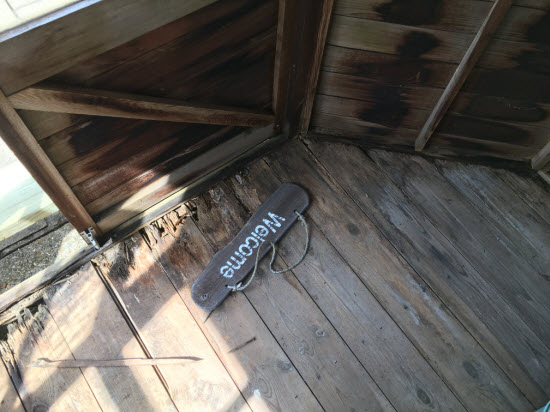 A view of the shed floor with splintering floorboards, spongy corners and decaying bearers underneath
A view of the shed floor with splintering floorboards, spongy corners and decaying bearers underneath
The worst part? The rest of the building was fine. If those bearers had been better protected - even just separated from direct contact with the ground - the whole repair job might have been unnecessary.
That's the thing about shed bearers. You don't see them. You rarely think about them. But they're the first line of defence between your shed and the soggy realities of the British climate.
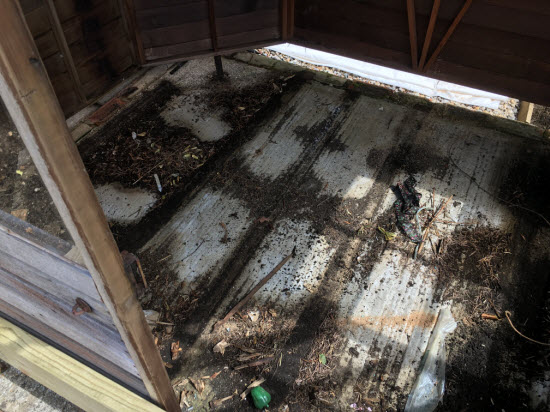 What it looked like when I removed the floor. You can see the lines of decayed wood where the bearers were.
What it looked like when I removed the floor. You can see the lines of decayed wood where the bearers were.
In this article, we'll look at what bearers are, why they matter, and how to protect them properly - including a few options, and one solution I now recommend to every customer: the Dryboot shed bearer protector.
What Is a Shed Bearer?
A shed bearer is a length of timber - usually pressure-treated - that runs horizontally underneath the shed floor. Its role is simple but crucial: to provide support for the structure above, and separation from the ground below.
Bearers sit between the shed and its base - often concrete slabs, blocks, or compacted gravel. This gap isn't just about keeping things level. It's there to allow air to circulate underneath the shed, which helps keep the timber dry and extends the life of the entire structure.
Left without ventilation, damp begins to build up. Moisture gets trapped between timber and concrete. And over time, that's when you start to see signs of trouble - soft bearers, warped flooring, and rot creeping into the lower frame.
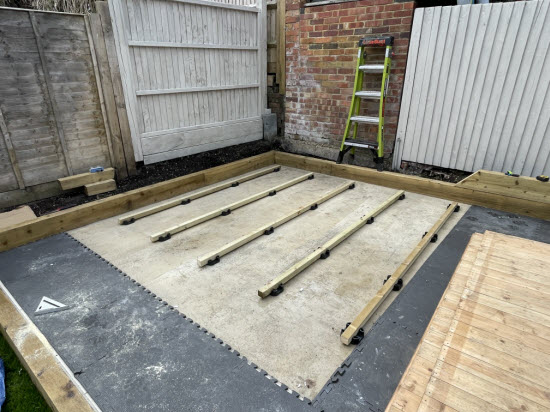 Lines of shed bearers ready to receive the shed floor panel
Lines of shed bearers ready to receive the shed floor panel
Bearers prevent that. They lift the shed just enough to avoid ground contact, help shed water, and maintain airflow where it matters most: beneath the floor, where few people ever look - until there's a problem.
What Is a Bearer on a Shed?
This is where shed talk often gets confusing. People throw around terms like base, skid, joist, and bearer as if they all mean the same thing. But in the context of British prefabricated sheds, a bearer does a very specific job - and it isn't quite the same as a joist.
Let's lay out the typical structure:
- First, you'e got your shed base - usually paving slabs, blocks, concrete, or a timber framework.
- Sitting directly on that base are the shed bearers - longer, treated timbers that run underneath the shed floor. These bearers act as spacers, lifting the shed just enough to allow airflow underneath and keep it off damp surfaces.
- On top of those bearers, you drop in the floor panel - often a prefabricated unit that includes both the joists and the floorboards, all built into one piece.
The real stack looks like this:
Ground - Bearers - Prefabricated Floor Panel (Joists + Floorboards)
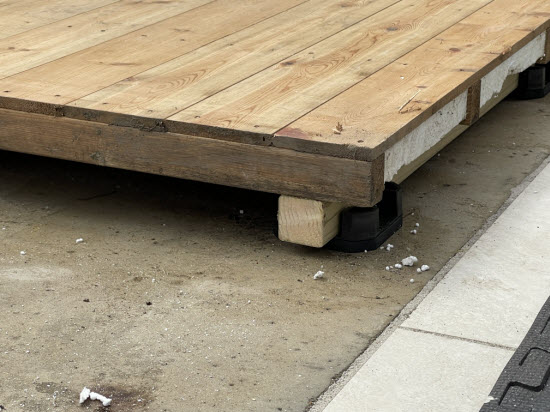 The concrete shed base, supporting shed bearers with the shed floor (comprising floor joists and boards) resting on top
The concrete shed base, supporting shed bearers with the shed floor (comprising floor joists and boards) resting on top
Unlike traditional deck framing, where bearers and joists are separate and sized differently, in many UK sheds the bearers and joists might be similar dimensions. But their roles are distinct. The bearers support the whole shed, lifting it clear of the ground. The joists support the floor, spreading the load of everything inside the shed.
In other words, the bearers aren't there to stiffen the floor - they're there to protect it from what's underneath.
Get the bearers wrong - too few, laid on soil, or in direct contact with concrete - and the problems don't take long to show up: soft corners, warped boards, and that tell-tale musty smell that says damp is creeping in.
What Is the Purpose of a Shed Bearer?
You wouldn't store your favourite tools in a puddle - but that's effectively what happens when a shed sits too close to the ground.
The primary job of a shed bearer is protection. Not of the shed walls or the roof - but of the floor. Bearers create a vital air gap between the shed and the surface below. That small gap might only be 50 to 75 millimetres, but it does a huge amount of work:
- Prevents water wicking from the ground or concrete into the timber floor
- Allows air to circulate, which helps dry out condensation and keeps moisture from settling
- Reduces the risk of rot, especially around floor edges and corners
- Spreads the load, keeping the shed stable even if the base isn't perfectly level
- Provides a buffer between your timber floor and frost, splashback, or leaf debris that can trap moisture
Without bearers, the shed floor sits in the danger zone - right where damp, decay, and insects like to hang out. And once the bearers go, the rest of the structure tends to follow.
That's why proper bearers aren't an optional extra. They're the first layer of defence. Quiet, humble, and mostly ignored - until something goes wrong.
How Many Bearers Do You Need for a Shed?
There's no one-size-fits-all answer - but there are a few solid rules of thumb.
The number of shed bearers you need depends on:
- The size of the shed
- The orientation and number of joists in the floor panel
- The size of the bearers themselves
- And, crucially, how well supported the bearers will be underneath (blocks, pads, or slabs)
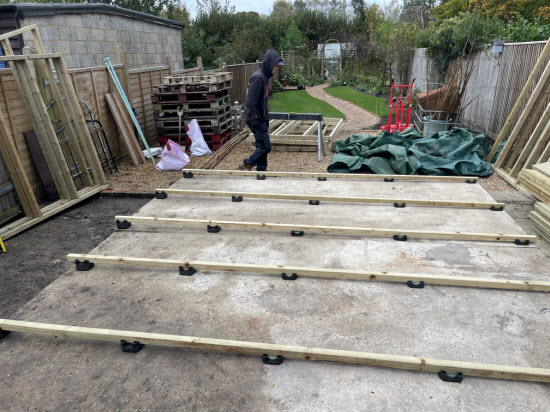 Shed bearers used for a larger shed
Shed bearers used for a larger shed
Let's break that down with some common examples.
Small Shed (e.g. 6ft x 4ft)
- Bearers needed: 3
- Position: One at each edge, one down the middle
Keeps the floor panel well-supported and evenly spaced.
Medium Shed (e.g. 8ft x 6ft or 10ft x 8ft)
- Bearers needed: 4 to 5
- Position: Evenly spaced, typically 400-600mm apart
More bearers = better load distribution and less risk of floor flex or sagging over time.
Large Shed or Workshop (e.g. 12ft x 10ft+)
- Bearers needed: 6+
Use spacing of 400mm-500mm centres if the floor will carry heavy loads (tools, workbenches, storage).
General Rule of Thumb
Keep bearer spacing within 600mm centres, and ensure bearers align under the joists in your floor panel. If in doubt, add one more.
Sheds aren't heavyweights by structural standards, but they don't like to flex. Floors with poor bearer support will creak, dip, or feel soft underfoot. And worse - undersupported bearers are more likely to sit in puddles or bend into soft ground, both of which open the door to decay.
Want to be safe? Over-support, not under. It's easier to get it right at the start than to retrofit new supports once the shed is in place.
What Is the Difference Between a Joist and a Bearer?
It's easy to confuse the two - joists and bearers are both bits of timber, they often look similar in size, and they both live under your feet. But they have different jobs.
Here's the simplest way to put it:
Joists support the floor. Bearers support the joists.
In a typical UK shed, the joists are part of the prefabricated floor panel - they run across the floor and give it strength. Your boards or flooring sheets are fixed on top of them. The joists carry the load from everything inside the shed: you, your mower, your workbench, your boxes of bits.
The bearers, by contrast, sit underneath that whole floor panel. Their job is to lift the shed up off the base, allow air to circulate underneath, and prevent the floor timbers from sitting in moisture.
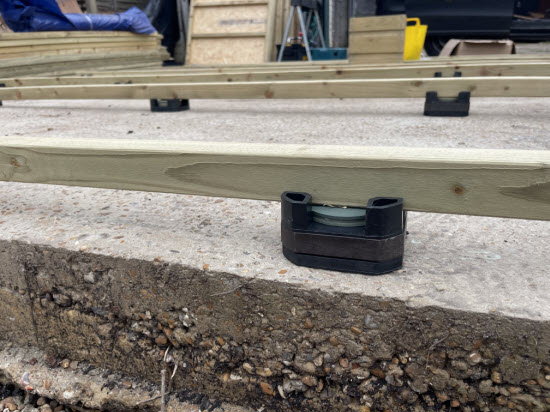 These bearers support the shed floor joists. The plastic 'Dryboot' cradles help to protect the bearer from damp as well as enabling levelling of this old concrete shed base.
These bearers support the shed floor joists. The plastic 'Dryboot' cradles help to protect the bearer from damp as well as enabling levelling of this old concrete shed base.
You can think of it as a simple stack:
Ground or slab ? Bearers ? Floor joists (inside the floor panel) ? Floorboards
They may look similar. They may even be cut from the same type of timber. But in a shed's anatomy, joists are part of the floor, while bearers are part of the foundation.
And here's the clincher: if the bearers fail, the joists eventually will too. Moisture works its way up, not down. So protecting the bearers is your first step to protecting everything else.
How to Protect Shed Bearers from Rot and Moisture
Let's get one thing clear: it's not just the weather that causes shed bearers to rot - it's trapped moisture.
The worst offenders?
- Bearers laid flat on concrete
- Bearers sat directly on soil or soft ground
- Or worse - a slab base with dips that collect rain, turning into a cold, wet sponge under your shed
Common Protection Methods
Most people do one of the following:
- Lay bearers on paving slabs or blocks - which works well if the surface is level and dry, but still allows water to wick in from below if it pools.
- Use pressure-treated timber - essential, yes, but treatment only slows rot; it doesn't make timber immune to it.
- Paint the underside with bitumen or use DPM strips - messy to apply, tricky to keep in place, and easy to forget or get wrong on install.
These are better than nothing. But they each have a weak point: they either assume a perfect base or rely on materials that degrade over time.
A Smarter Way to Keep Bearers Dry: Dryboot Shed Bearer Protectors
This is why I now recommend - and use - Dryboot shed bearer protectors on all my floor installs.
Dryboot is a plastic cradle that lifts each bearer at least 10mm off the ground. It creates a physical gap between timber and concrete - exactly where most rot starts. But what makes it so effective is how it works: at isolated contact points, rather than covering the full length of the bearer. This preserves airflow while keeping the timber clear of damp.
Better still, Dryboot comes with interchangeable shims and packers, so if your concrete base isn't perfectly level (and let's be honest - most aren't), you can adjust each support quickly and precisely. No wobbles, no makeshift padding, and no direct contact with cold, damp surfaces.
In short:
- Quick to fit
- Neat and durable
- Solves the weak spot in almost every shed base
- Keeps your bearers dry without fuss
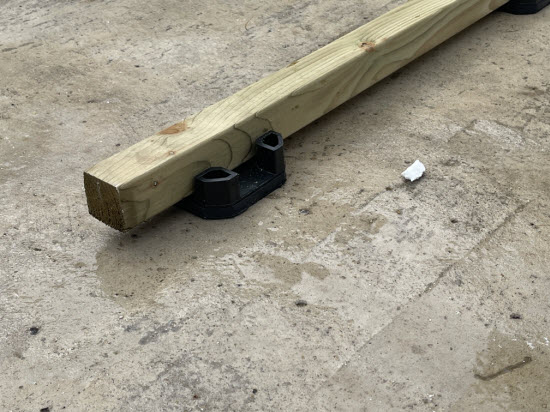 A Dryboot shed bearer protector doing its job of lifting the bearer above the damp concrete shed base
A Dryboot shed bearer protector doing its job of lifting the bearer above the damp concrete shed base
It's a small upgrade, but one that often saves the floor - and everything above it.
Want to see how it works? Here's the full Dryboot product page
FAQs About Shed Bearers
Do I need bearers under my shed if I already have a concrete base?
Yes. A concrete base holds weight, but it also holds water. Bearers keep your timber floor off that cold, damp surface - preventing rot and allowing air to circulate beneath the shed. Without bearers, moisture gets trapped, and problems follow.
How far apart should shed bearers be?
As a rule of thumb, space bearers no more than 600mm apart - closer if you expect heavy loads. The idea is to support the joists above without allowing flex or sag. More bearers = better support.
Should bearers run lengthways or across?
Bearers should run in the opposite direction to the joists inside your floor panel. If your floor joists run left to right, run your bearers front to back - this gives proper support across the span.
Can I use decking joists as shed bearers?
Yes, as long as they're pressure-treated and sized appropriately (often 4x2 or 3x2). But remember: treatment slows decay - it doesn't stop it. It's what the timber sits on that really makes the difference.
Do I still need bearers if I'm using plastic shed base grids?
Sometimes no - if the grid base has full coverage and good drainage, it may support the floor directly. But with larger sheds or uneven ground, bearers still help spread the load and reduce flex.
What's the best way to protect bearers from moisture?
Pressure treatment helps, but keeping bearers raised and ventilated is key. Slabs, blocks, or even better - Dryboot bearer protectors - all help stop direct moisture contact and extend the life of your floor.
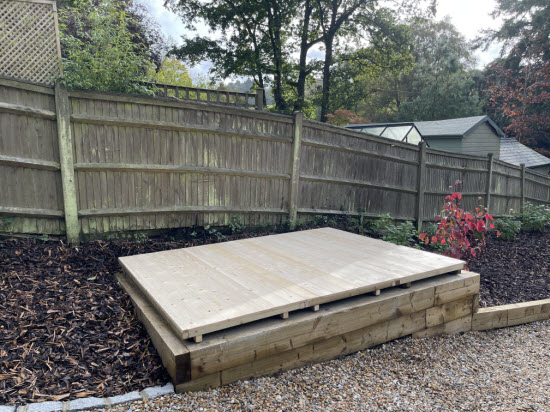 A shed floor, with bearers and Dryboot bearer protectors beneath, supported on a concrete shed base.
A shed floor, with bearers and Dryboot bearer protectors beneath, supported on a concrete shed base.
Summary & Practical Takeaways
When I first inspected that customer's summerhouse, the problem wasn't in the roof, the walls, or the joinery - it was in the bearers. They'd done their job for a few years, then slowly started to fail at the point most people forget about: where timber meets the ground.
By the time I was called in, rot had spread up into the floor frame and cladding. But the warning signs had been there all along - subsidence, spongy corners, and damp patches creeping in.
That's why this matters.
Bearers may not be the most visible part of your shed, but they're one of the most important. Get them right, and your floor stays solid, your tools stay dry, and you avoid years of creeping damage.
Here's the quick takeaway:
- Use pressure treated timber
- Raise your bearers off the ground (even by just 10mm)
- Space them properly - 600mm max, closer for heavier loads
- Use Dryboot shed bearer protectors to solve the moisture contact problem once and for all
A little thought beneath your floor goes a long way.

Keep in touch with our monthly newsletter
Shed Building Monthly




